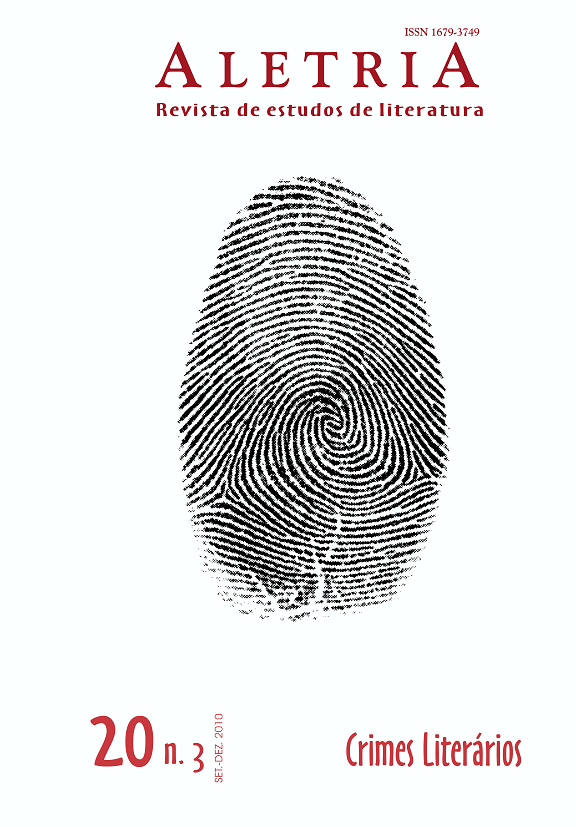Pequenos golpes e astúcias sutis: a figura do trickster na série Blanche white mysteries, de Barbara Neely
DOI:
https://doi.org/10.17851/2317-2096.20.3.159-175Palavras-chave:
romance policial, contraliteraturas, periferiaResumo
As práticas cotidianas – especialmente os pequenos golpes e astúcias que caracterizam a figura do trickster – marcam presença na série Blanche white mysteries, de Barbara Neely, objeto de estudo deste artigo. Tomando como base para argumentação a teoria de Michel de Certeau sobre a práxis cotidiana, desenvolvida em A invenção do cotidiano, busca-se discutir de que forma essas práticas se re-significam no embate entre o centro de poder e grupos “invisíveis”, além do seu papel político como uma tática de resistência empregada como oposição a práticas socioculturais dominantes.
Downloads
Referências
CARY, Alice. Grandma just liked to boogie. The Boston Globe, May 9th, 2004. Disponível em: http://www.wumb.org/about/press/Grandmothershands.doc. Acesso em: 23 jul. 2006.
CERTEAU, Michel de (1994). A invenção do cotidiano: 1. Artes de fazer. Trad. Ephraim Ferreira Alves. Petrópolis: Vozes, 2005.
DuBOIS, W. E. B. The souls of black folk. Disponível em: http://www.bartleby.com/114. Acesso em: 8 nov. 2008.
ELLISON, Ralph (1952). Invisible man. New York: Vintage, 1995.
GATES Jr., Henry Louis. The signifying monkey: a theory of African American literary criticism. New York: Oxford UP, 1988.
GOELLER, Allison D. An interview with Barbara Neely. In: MUELLER, Monika; FISCHER- HORNUNG, Dorothea. Sleuthing ethnicity: the detective in multiethnic crime fiction. Madison: Fairleigh Dickinson University Press; London: Associated University Presses, 2003. p. 299-307.
GONZÁLEZ, Mario M. A saga do anti-herói. Estudo sobre o romance picaresco clássico espanhol e algumas de suas correspondências na literatura brasileira. São Paulo: Nova Alexandria, 1994.
GWIN, Minrose. A theory of black women’s texts and white women’s readings, or ... the necessity of being other. NWSA Journal, v. 1, n. 1, p. 21-31, 1988.
HATHAWAY, Rosemary V. The signifyin(g) detective: Barbara Neely’s Blanche White, undercover in plain sight. Critique, v. 46, n. 4, p. 320-332, 2005.
LIBRETTI, Tim. Lucha Corpi and the politics of detective fiction. In: GOSSELIN, Adrienne Johnson (Ed.). Multicultural detective fiction: Murder from the ‘Other’ Side. Ed. Adrienne Johnson Gosselin. [Garland Reference Library of the Humanities, v. 2094]. New York: Garland Publishing, 1998. p. 61-81
LYNE, William. The signifying modernist: Ralph Ellison and the limits of double consciousness. PMLA, v. 107, n. 2, p. 319-330, 1992.
MUELLER, Monika. A Cuban American “Lady Dick” and an African American Miss Marple?: the female detective in the novels of Carolina García-Aguilera and Barbara Neely”. In: MUELLER, Monika; FISCHER-HORNUNG, Dorothea (Ed.). Sleuthing ethnicity: the detective in multiethnic crime fiction. Madison: Fairleigh Dickinson University Press; London: Associated University Presses, 2003. p. 114-132.
NEELY, Barbara. Blanche on the lam. New York: Penguin, 1992.
NEELY, Barbara. Blanche among the talented tenth. New York: Penguin, 1994.
OLDERMAN, Raymond M. Ralph Ellison’s blues and Invisible man. Wisconsin Studies in Contemporary Literature, v. 7, n. 2, p. 142-159, 1966.
PONIATOWSKA, Elena. Mexicanas and chicanas. MELUS, v. 21, n. 3, 1996.
PORTILHO, Carla. Contra-escrituras chicanas: revisitando mitos e subvertendo gêneros. 2004. 100 f. Dissertação (Mestrado em Letras – Literaturas Hispânicas) – Instituto de Letras, Universidade Federal Fluminense, Niterói, 2004.
QUEIROZ, Renato da Silva. O herói trapaceiro: reflexões sobre a figura do trickster. Tempo Social, Rev. Sociol. USP, São Paulo, v. 3, n. 1-2, p. 93-107, 1991. Disponível em: http://www.fflch.usp.br/sociologia/revistas/tempo-social/v3-1e2/queiroz.html. Acesso em: 21 nov. 2006.
REDDY, Maureen T. Traces, codes, and clues: reading race in crime fiction. New Brunswick, N.J.: Rutgers University Press, 2003.
SCHILLER, Beate. Between Afrocentrism and universality: detective fiction by black women. Disponível em: http://opus.kobv.de/ubp/volltexte/2005/547/pdf/schiller.pdf. Acesso em 16 out. 2006.
SOMMER, Doris. Textual conquests: on readerly competence and “minority” literature. Modern Language Quarterly, v. 54, n. 1, p. 141-153, 1993.
TOLSON, Nancy D. The butler didn’t do it, so now they’re blaming the maid: defining a black feminist trickster through the novels of Barbara Neely. South Central Review, Baltimore, v. 18, n. 3/4, p. 72-85, 2001. Número especial: Whose body: recognizing feminist mystery and detective fiction.
WEATE, Jeremy. Changing the joke: invisibility in Merleau-Ponty and Ellison. Philosophia Africana, v. 6. n. 1, p. 5-21, 2003
WITT, Doris. Detecting Bodies: Barbara Neely’s domestic sleuth and the trope of the (in)visible woman. In: BENNETT, Michael; DICKERSON, Vanessa D. (Ed.). Recovering the black female body: self-representations by African American women. New Brunswick, N.J.: Rutgers University Press, p. 165-194.
Downloads
Publicado
Edição
Seção
Licença
Copyright (c) 2010 Carla Figueiredo Portilho (Autor)

Este trabalho está licenciado sob uma licença Creative Commons Attribution 4.0 International License.
Autores que publicam nesta revista concordam com os seguintes termos:Autores mantém os direitos autorais e concedem à revista o direito de primeira publicação, com o trabalho simultaneamente licenciado sob a Licença Creative Commons Attribution que permite o compartilhamento do trabalho com reconhecimento da autoria e publicação inicial nesta revista.Autores têm autorização para assumir contratos adicionais separadamente, para distribuição não-exclusiva da versão do trabalho publicada nesta revista (ex.: publicar em repositório institucional ou como capítulo de livro), com reconhecimento de autoria e publicação inicial nesta revista.Autores têm permissão e são estimulados a publicar e distribuir seu trabalho online (ex.: em repositórios institucionais ou na sua página pessoal) a qualquer ponto antes ou durante o processo editorial, já que isso pode gerar alterações produtivas, bem como aumentar o impacto e a citação do trabalho publicado (Veja The Effect of Open Access).














